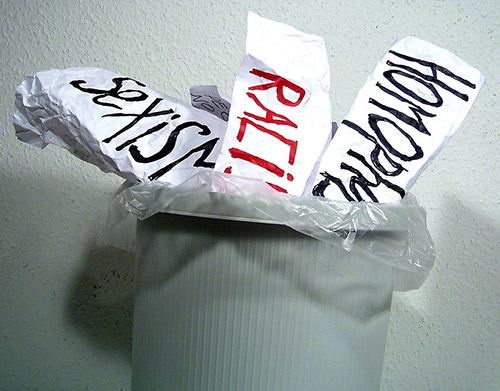This past April, while many of my fellow Ooligan students were at AWP 2016 in Los Angeles, I opted for a conference that was smaller yet just as important: ACES 2016, the twentieth anniversary of the American Copy Editors Society’s annual festival of unabashed grammar geekery and word nerdery, lovingly dubbed “Comma-Con” by some of its attendees. This year’s conference took place here in Portland and featured such word-nerd luminaries as Carol Saller, editor of the Chicago Manual of Style’s online Q&A and author of The Subversive Copy Editor; Jonathon Owen of Arrant Pedantry; Marnie Shure, managing editor of the Onion; and Kory Stamper, the fiercely witty Merriam-Webster editor and lexicographer as well as the keynote speaker for the event.
ACES 2016 was packed with excellent panels covering everything from best practices for freelancers to whether “turdmonger” is a closed compound, but the highlight for me was a panel called “Sexist Creeps.” The panel covered the ways sexist or biased language can creep into a piece of writing regardless of the author’s intentions. An author is not typically intending to use biased language, but it is so common that it’s easy to overlook—for example, descriptions of female politicians often include far more information about their physical characteristics than descriptions of male politicians.
Biased language extends far beyond depictions of women and men: as editors, we must also be alert to potentially othering language around gender and sexuality, ability and disability, and ethnicity and nationality. A good rule of thumb is to only include as much information about a person as is necessary and relevant to the topic at hand—when in doubt, delete. Unfortunately, it’s not unusual to encounter resistance from writers and bosses who minimize or deny the problematic nature of biased language. The moderator of Sexist Creeps, Colleen Barry, recommended the following steps for querying problematic writing:
- Question the language, not the author, and assume the author’s best intentions.
- Sincerely listen to the response.
- Propose at least one solution, preferably several.
- Respectfully push past the first “no.”
- If you get a second “no,” appeal to a higher authority or back down gracefully—raising the issue is still a success.
- Regardless of the outcome, thank the author for their* willingness to discuss the issue.
*Ah, yes, the ever-contested singular they. Step 6.5 might be to wholeheartedly embrace this controversial word; it’s like the superfood of inclusive language.
Still, despite our best intentions, it can be difficult to know what editorial choices or queries to make when language is constantly in flux. We first turn to dictionaries and style guides, but they are not necessarily the best resources for the vast pool of concepts and descriptors available to represent people in an inclusive, unbiased way. Stepping in to fill that gap is Karen Yin, one of the Sexist Creeps panelists, who founded the Conscious Style Guide in 2015. The guide is a thoughtful compendium of articles spanning the range of inclusive language issues, and it’s an excellent editorial asset for educating ourselves, staying on top of the conversation, and reinforcing our suggestions to strive toward inclusive language.

